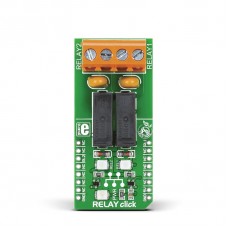RELAY click
RELAY click can control various devices with up to 5A, 250V AC/30V DC loads. It features two G6D1AASI-5DC power PCB relay modules. The click is designed to run on 5V power supply only. RELAY click communicates with the target microcontroller via mikroBUS™ PWM (RL1) and CS (RL2) pins.
RELAY click is a compact and easy solution for adding a relay to your design. The two screw terminals onboard allow seamless connectivity.
 DO NOT TOUCH THE BOARD WHILE THE EXTERNAL POWER SUPPLY IS ON!
DO NOT TOUCH THE BOARD WHILE THE EXTERNAL POWER SUPPLY IS ON!
Note: RELAY click has exposed pins/pads. To stay safe take precaution when applying high voltage to the click. The click is to be used by trained personnel only when applying high voltage.
G6D1AASI-5DC power PCB relay
The maximum contact resistance of the G6D1AASI-5DC relay is 100 mΩ.
Communication lines
Communication lines voltage level can be in range between 3.3V and 5V. On-board transistors are used to drive relays by current sinking.
Relay information
A relay is an electrical switch used to terminate or establish a circuit using a low power signal from a microcontroller. It provides complete electrical isolation between microcontroller and controlled circuits. Use the RELAY click™ board with its two G6D1AASI-5DC relays to control various devices with up to 5A, 250V AC/30V DC loads.
Key features
- On-board screw terminals
- G6D1AASI-5DC power PCB relay
- Contact resistance: 100 mΩ max.
- Max. switching voltage 250 VAC, 30 VDC
- Max. switching current 5 A
- Interface: PWM and CS pins
- 5V power supply
Specification
| Type | Relay |
| Applications | Board can be used for turning on/off lights, motors and other high power consumers within the maximum supported voltage/current levels |
| On-board modules | G6D1AASI-5DC power PCB relay |
| Key Features | Control up to 5A, 250V AC/30V DC loads |
| Key Benefits | Screw terminals allow seamless connectivity |
| Interface | GPIO |
| Input Voltage | 5V,5V |
| Compatibility | mikroBUS |
| Click board size | L (57.15 x 25.4 mm) |
Downloads
mikroBUS™ Standard specification
Pinout diagram
This table shows how the pinout on RELAY click corresponds to the pinout on the mikroBUS™ socket (the latter shown in the two middle columns).
Programming
Code examples that demonstrate the usage of RELAY click with MikroElektronika hardware, written for mikroC for ARM, AVR, PIC and PIC32 are available on Libstock.
The following code snippet is a simple example of RELAY click toggled with buttons on an EasyPIC v7.
1 sbit Relay1 at LATC1_bit;
2 sbit Relay2 at LATE0_bit;
3 sbit Relay1_Direction at TRISC1_bit;
4 sbit Relay2_Direction at TRISE0_bit;
5 void main()
6 {
7 Relay1_Direction = 0; // Set relay direction as output
8 Relay2_Direction = 0; // Set relay direction as output
9 Relay1 = 0; // Turn off relay1
10 Relay2 = 0; // Turn off relay2
11
12 while( 1 )
13 {
14 if( Button( &PORTB, 0, 80, 1 ) ) // Toggle relay 1 on B0 button press
15 Relay1 = ~Relay1;
16
17 if( Button( &PORTB, 1, 80, 1 ) ) // Toggle relay 2 on B1 button press
18 Relay2 = ~Realy2;
19 }
20 }
Enter the code in the box below:












